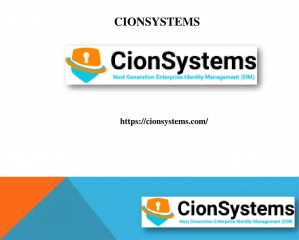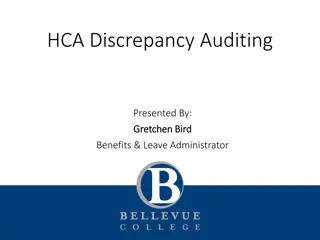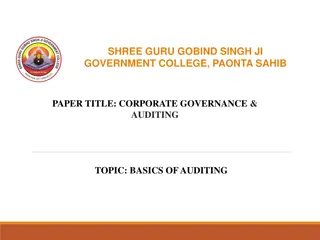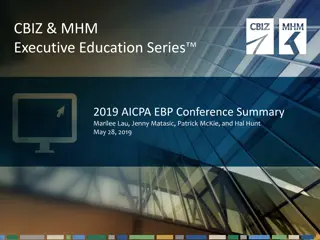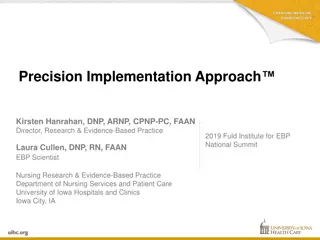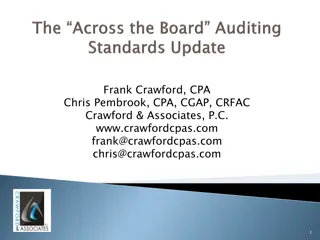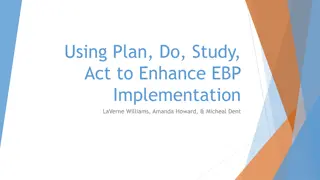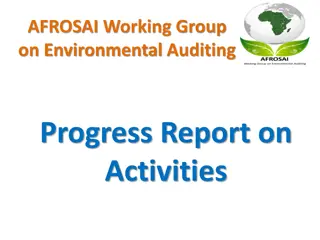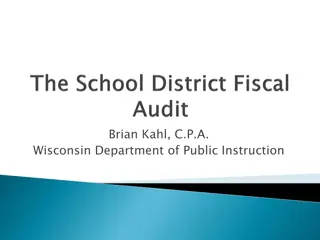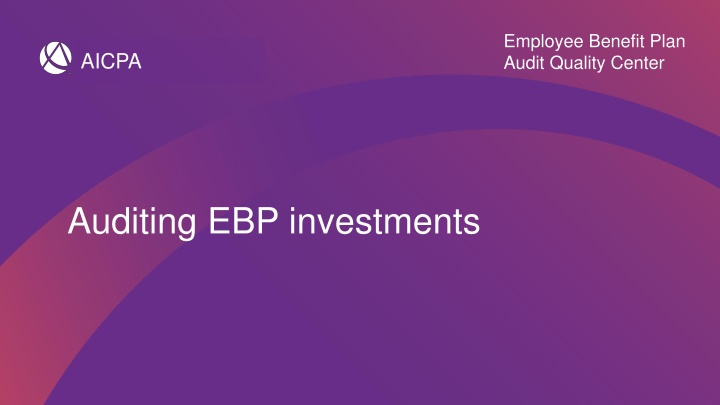
Audit Planning and Investment Management for Employee Benefit Plans
Explore audit planning and investment management strategies for employee benefit plans in this comprehensive resource. Learn about audit procedures, common deficiencies, and key considerations for managing plan investments effectively. Join industry experts for valuable insights and discussions on relevant topics to enhance your understanding of Employee Benefit Plan Audit Quality Center resources.
Download Presentation

Please find below an Image/Link to download the presentation.
The content on the website is provided AS IS for your information and personal use only. It may not be sold, licensed, or shared on other websites without obtaining consent from the author. If you encounter any issues during the download, it is possible that the publisher has removed the file from their server.
You are allowed to download the files provided on this website for personal or commercial use, subject to the condition that they are used lawfully. All files are the property of their respective owners.
The content on the website is provided AS IS for your information and personal use only. It may not be sold, licensed, or shared on other websites without obtaining consent from the author.
E N D
Presentation Transcript
Employee Benefit Plan Audit Quality Center AICPA Auditing EBP investments
Handouts for todays event You can download presentation slides (in PDF or PowerPoint format) and other handouts by clicking on in the toolbar at the bottom of your screen Instructions to obtain your CPE certificate for today s event Webinar presentation slides Summary of EBPAQC resources and tools EBPAQC Topix Primers Insurance Company Products Offered to Employee Benefit Plans Plan Investments in Bank Collective Investment Funds Stable Value Funds and Investment Contracts An Overview EBPAQC tools Documentation of Use of a Type 2 Service Auditor s Report in an Audit of an Employee Benefit Plan s Financial Statements Common Deficiencies in Employee Benefit Plan Limited Scope Audit Certifications Documentation of the Auditor s Evaluation of a Limited Scope Audit Certification 2
Speakers Michele Weldon PwC Debbie Smith Grant Thornton Jen Allen Crowe LLP 3
Discussion topics Planning Relevant audit procedures related to investments in a full scope audit When a limited scope audit may be performed and appropriate evidence to be obtained Auditing in the current environment For information about EBP investment types and the related accounting and reporting, view the EBPAQC s archived webinar, Common EBP investments: accounting and reporting 4
Planning Establish plan management responsibilities Assess management s understanding of their investment portfolio Do they understand what type of investments they have Do they understand the definition of a fully benefit-responsive contract Do they understand the concept of net asset value (NAV) as readily determinable fair value (RDFV) vs. NAV as a practical expedient Consider any involvement of third-party service organizations (investment advisers or managers) Consider management's financial reporting expertise
Planning: gaining an understanding of the plans investments Inquire of the plan sponsor Inquire of the investment service providers Review of statements from trustee /custodian Review of plan document Review of investment policy statement Read investment committee / other governance minutes Read agreements / contracts
Planning: internal control evaluation Auditor responsibilities Obtain an understanding of internal control relevant to the audit Evaluate the design of controls and determine whether they have been implemented Inquiry alone is not sufficient
Planning: do you need a SOC 1 report that covers investments? Limited scope audit Because there is no testing of investment balances or related investment income, a SOC 1 report covering investments is not needed from the trustee/custodian. Full scope audit Because auditor is testing investment values and related investment income, a SOC 1 report from the entity holding the investments can help obtain an understanding of internal controls. The SOC 1 report could also help reduce (but not eliminate) testing.
Types of SOC 1 reports Two types of SOC 1 reports Type 1 report report on the fairness of the presentation of management s description of the service organization s system and the suitability of the design of the controls to achieve the related control objectives included in the description as of a specified date Type 2 report report on the fairness of the presentation of management s description of the service organization s system and the suitability of the design and operating effectiveness of the controls to achieve the related control objectives included in the description throughout a specified period Type 2 report can be used to reduce testing
Common pitfalls: SOC 1 reports Report opinion qualifications or testing exceptions Report carve outs SOC 1 report covers a different period (may need to obtain a bridge letter/gap letter) Complementary user entity controls not tested Misconceptions about coverage Overreliance on information reported by service providers
Risk assessment Areas that may present particular risks of material misstatement at the assertion level for classes of transaction, account balances, and disclosures in the area of investments may include Valuation of investments Unobservable inputs Daily valued investments Trade date vs. settlement date Accounting and disclosure of types of investments specific to EBPs, such as insurance products, stable value products, derivatives, and securities lending Availability of appropriate service organization reports
Risk assessment procedures Inquiries of Management within the entity who may have information likely to assist in identifying risks of material misstatement due to fraud or error External parties involved with the plan s investments, such as the service organizations, including the third-party administrator, recordkeeper, trustee or custodian, investment advisor, or valuation specialist Analytical procedures Comparison of investment return with published benchmarks Review fluctuations of account balances to highlight unusual variances Observation and inspection Read investment committee minutes and the investment policy Inspect custodian s or investment manager s investment agreement Inspect investment statements (trust statements)
Common pitfalls: risk assessment Did not perform procedures to obtain an understanding of the plan s investment strategy and assessing the inherent risk of the investments held by the plan Did not perform an analysis of changes in investments during the period and evaluate if situations arose that violate applicable laws or regulations in relation to the plan s investments. Improper identification of investments
Common deficiencies in auditing investments No testing of investment valuations No testing of existence of investments No testing of investment transactions No determination of reasonableness of investment income Confirmation of investments was not obtained No testing of allocations of investment income No audit evidence to provide reasonable assurance that fair value measurements and disclosures are in conformity with GAAP No audit documentation to substantiate the fair value hierarchy classification Improper identification of investments
Relevant assertions: existence or occurrence/completeness All investments are recorded and exist. Investment principal and income transactions (including net appreciation) are recorded. Investments and investment transactions are initiated in accordance with the established investment policies and comply with plan provisions.
Audit procedures: existence or occurrence/completeness Confirm existence Vouch receipts and disbursements Review subsequent receipts and disbursements
Unique issues: confirmations To what party should the auditor send the confirmation (e.g., fund manager, trustee)? Auditor control of the confirmation process Be sure to send a confirmation request, even if information is available through a portal.
Relevant assertions: valuation or allocation and cutoff All investments are valued as of the plan s year-end in accordance with the applicable financial reporting framework. Investment principal and income transactions (including net appreciation) are properly valued in accordance with the applicable financial reporting framework. All investment transactions are recorded in the correct period.
Audit procedures: valuation/allocation and cutoff Test the fair value of investments Test investment income Test investment transactions Test the computation of the net change in appreciation/depreciation of the fair value of investments Determine if investment transactions are recorded in the proper period
Valuation Sources of prices Pricing services Investment advisor statements Brokers Outside valuation specialists Management Some pricing services have SOC 1 Reports
Relevant assertions: other Rights and obligations All investments owned by the plan are free of liens, pledges, and other security interests. Presentation and disclosure Investments are properly presented and described in accordance with the applicable financial reporting framework.
Common and preferred stock: audit procedures Confirm existence with custodian/trustee Examine minutes, agreements, confirmations for evidence of liens, pledges, or other security interests Evaluate whether FV measurements and disclosures are in accordance with GAAP and are consistent between periods Test purchases and sales transactions Examine subsequent transactions Evaluate compliance with the plan s investment policy or other applicable agreements or applicable laws/regulations 24
Common and preferred stock: audit procedures (contd) For readily marketable: Compare value at year end and for transactions to quoted market prices Evaluate gains and losses on sales Evaluate net appreciation/depreciation and income earned/accrued For non-readily marketable: Understand process and controls over FV measurement & disclosures Evaluate Use of Specialist (appraisal or pricing service) Qualifications and objectivity Methods and assumptions Data used in appraisal Evaluate net appreciation/depreciation and income earned/accrued 25
Mutual funds and other registered funds: audit procedures Confirm positions held Test fair value back to published source (or to audited financial statements) Compare net appreciation/depreciation to changes in prices for the period for reasonableness Recalculate dividends or perform total return analysis Look for a SOC 1 report for service provider to potentially reduce scope of testing Test purchases and sales transactions 26
Common pitfalls: mutual funds Registered investment company investments incorrectly recorded at NAV as a practical expedient that should be recorded at RDFV Investments not included in appropriate fair value hierarchy level category (Level 1, 2 or 3) or improperly included in hierarchy table Not understanding whether investment has an RDFV or uses NAV as practical expedient
Bonds: audit procedures Confirm existence Test quoted prices if marketable (using CUSIP # s) Evaluate management methods & assumptions, consider use of specialist (if nonmarketable) Evaluate reasonableness of interest income Test purchases and sales transactions Examine subsequent transactions 28
Common pitfalls: bonds Failing to understand the inputs used when valuing bonds leading to incorrect leveling in the fair value hierarchy table Treating all fixed income securities the same rather than evaluating them individually (corporate bonds, US Treasury, municipal bonds, etc.- not all the same)
CCTs and PSAs: audit procedures Examine the contracts to understand the investment Confirm units held by plan directly with trustee/advisor or bank Compare information in plan s financials (fair value (or NAV), changes in fair value, income earned/accrued, etc..) to fund s audited financial statements Examine supporting documents for investment transactions (committee minutes, trust agreements, investment guidelines) Perform procedures when there are significant gaps between date of fund s audited financials and plan year-end (see AU-C section 501, parag .04) 30
Common pitfalls: CCTs and PSAs Incorrectly mistaking a CCT or PSA for a mutual fund resulting in Improper audit procedures Improper presentation and disclosure
Stable value investments: audit procedures Confirm existence and terms of agreements Examine contracts to evaluate ownership and if it is a fully benefit responsive investment contract (FBRIC) Determine whether expenses charged are in accordance with contract For traditional Guaranteed Investment Contracts (GICs): Evaluate reasonableness of interest credited in relation to crediting rate For synthetic GICs or indirect FBRICs (e.g., stable value collective funds): Compare plan information to audited fund financials (if available), or Test valuation of underlying securities and value of wrapper Use a valuation specialist (if needed) 32
Common pitfalls: stable value investments Failure to understand the type of stable value investment and related reporting and disclosure requirements FBRICs improperly included in hierarchy table FBRICs measured at fair value and/or included in fair value hierarchy table Underlying securities of a synthetic investment contract included in the fair value hierarchy table Indirect FBRICs Improperly reported with investments at contract value and excluded from the fair value measurement disclosures
Self-directed brokerage accounts: audit procedures Identify nature/type of investments held in self-directed brokerage accounts (SDBAs) Test existence and valuation of investments held in SDBAs based on the investment understanding (see prior slides) Confirm information independently with the Broker (if considered necessary) Perform appropriate tests of transactions and earnings for SDBA investments (based on the nature/type of investment) Purchases and sales testing Interest and dividends testing 34
Common pitfalls: self-directed brokerage accounts Failure to understand service provider reporting How summary trust and recordkeeping reports reconcile Material gross reconciling items not tested Failure to one-line item report the SDBA in the fair value hierarchy table
Derivatives: audit procedures Obtain a listing of derivatives from the plan, including activity during the year (and reconcile to confirms and other detailed reports) Confirm Existence of derivatives with the counterparty With the holder of the security, including securities in electronic form, or with the counterparty to the derivative Confirm settled and unsettled transactions with the broker-dealer or counterparty Physically inspect the security or derivative contract Read Executed agreements Other information, such as minutes of meetings of the board of directors or finance, investment, or other committees 36
Derivatives: audit procedures (contd) Inspect Underlying agreements and other forms of supporting documentation (in paper or electronic form) Supporting documentation for subsequent realization or settlement after the end of the reporting period Financial instruments and other agreements to identify embedded derivatives Documentation in paper or electronic form for activity subsequent to the end of the reporting period Recalculate gains and losses on derivatives closed out during the year Vouch derivative payments and receipts during the year Obtain the basis for determining fair value of derivatives and testing valuation assertions 37
Derivatives: common pitfalls Automatically defaulting to derivatives being immaterial without fully understanding nature and risks Not understanding what is in the other investment or receivable payable balance on statement of net assets Relying solely on trustee statements that show net positions versus gross Obtain underlying derivative statements 38
Real estate: audit procedures Examine Closing and other documents supporting the cost of the real estate Deeds, title policies, encumbrances, and other evidence related to ownership Current-year tax bills and relating them to property descriptions Test fair value Use of specialist? Test investment income from real estate, such as rents, and payments of related expenses, such as taxes and maintenance Inquire whether the plan s investments or other transactions violate applicable laws or regulations 39
Alternative investments: audit procedures Obtain confirmation of the plan s holdings in the alternative investments from the investment adviser (including activity during the year and percentage ownership) Determine valuation methodology (e.g. NAV as a practical expedient or other fair value estimation technique) Obtain a copy of audited financial statements and year-end capital allocation schedule from investment adviser Relate reasonableness of value reported in financial statements and allocation schedule to value recorded by participating plan, including fair value, purchases and sales value, income earned, and income accrued Examine documents approving and supporting selected investment purchase and sale transactions (such as, subscription and redemption documentation, investment agreement, and minutes of meeting) 40
Alternative investments: audit procedures (contd) Consider additional procedures if no audited FS are available or for non-conterminous year-end based on materiality/risk: Obtaining copy of holdings and inquiring of management regarding valuation methods Obtaining a copy of appraisal, if applicable Obtaining an understanding of controls/risk (obtain SOC 1 report, if any) Obtaining an analysis of changes in investments during the period Obtaining evidence regarding the existence and ownership of underlying investments Reviewing minutes, agreements, and confirmations for evidence of liens, pledges, or other security interest in investments. 41
Alternative investments: audit procedures (contd) Performing tests of investment transactions, that may include Determining that they were properly authorized Examining cash disbursement records or other supporting documentation for the historical cost or selling price, quantity, identification, and date of acquisition and disposal Agreeing purchases and sales values to supporting evidence (including information provided by an outside specialist, if applicable) for price ranges on the trade dates Checking the computation of the net change in appreciation or depreciation Testing the fair value of investments, in accordance with AU-C section 501 or 540, as applicable Inquiring whether the plan s investments or other transactions violate applicable laws or regulations 42
Auditing Unitized Accounts and Separately Managed Accounts Assets are held in an account and a unitized price is determined at which purchases and sales are transacted. Read agreements to determine if account meets definition of investment company/NAV as a practical expedient or should be accounted for as individual assets Assets are held in the name of the plan and should be audited in a manner similar to other individual investments held directly by plan. Individual assets of a unitized/separately managed account are held in the name of the plan and are included in financial statement disclosures (ASC 820) and on Schedule H of Form 5500 43
Limited scope audits investments procedures
Limited scope exemption Election permitted by ERISA section 103(a)(3)(C) Limited scope audit procedures performed on investments if certified complete and accurate Certification applies only to investments, investment transactions, investment income All other areas of plan activity same procedures as for a full scope audit
Limited scope certification Obtain understanding of investments covered by certification Review FS disclosures, agreements, investment statements, discussions with management/service providers Determine eligibility of certifying entity in accordance with DOL Regulation 2520.103-5 Review wording of the certification Bring unusual items that come to your attention to the plan administrator
Limited scope audit procedures: investments Compare certified information to form and content of financial statements and footnote disclosures and reporting on Form 5500 Determine that the financial statements, disclosures and supplemental schedules are in compliance with GAAP and DOL requirements Watch for Footnote identifies what information was covered by the certification.
Limited scope audits: common audit deficiencies related to investment information No testing of allocations of investment income No audit evidence to provide reasonable assurance that fair value measurements and disclosures are in conformity with GAAP No audit documentation to substantiate the fair value hierarchy classification Improper identification of investments
Common audit deficiencies: limited scope audits No testing of investments that were not included under the custodian/trustee certification No certification in the audit workpapers No testing of fair value disclosures, including leveling Failure to audit areas not subject to the limited scope exception Improper certification
Limited scope audits: improper certification Institution issuing the certification was not a qualified institution under 29 CFR 2520.103-5, i.e., an insurance company, bank or trust company The certification did not state that the information was complete and accurate Certification not consistent with the plan s reporting period Certifying entity not in position to certify investments May have to carve those assets out and not limit audit scope if it comes to your attention that they are not in a position to certify Use EBPAQC tools: Common Deficiencies in Employee Benefit Plan Limited Scope Audit Certifications Documentation of the Auditor s Evaluation of a Limited Scope Audit Certification


